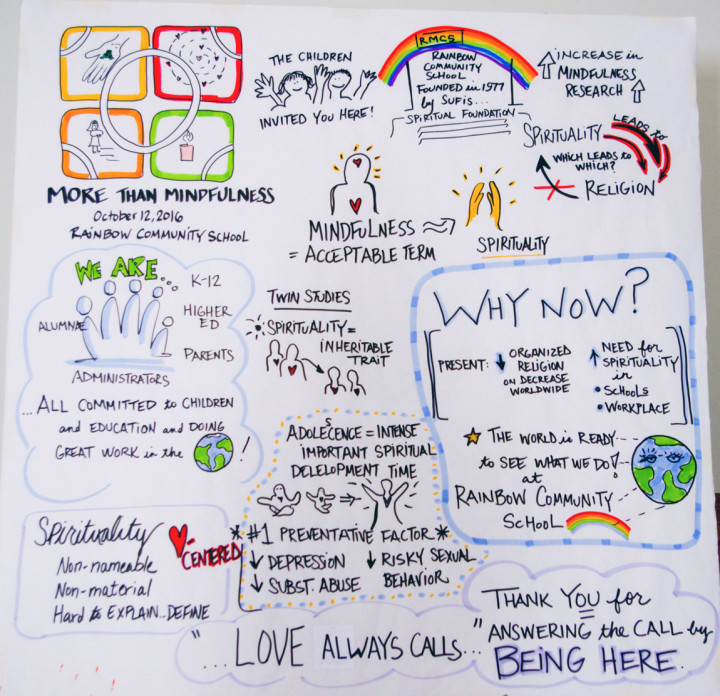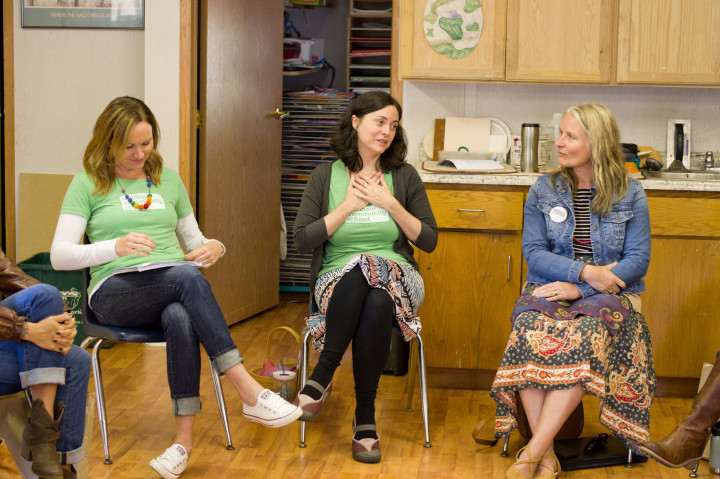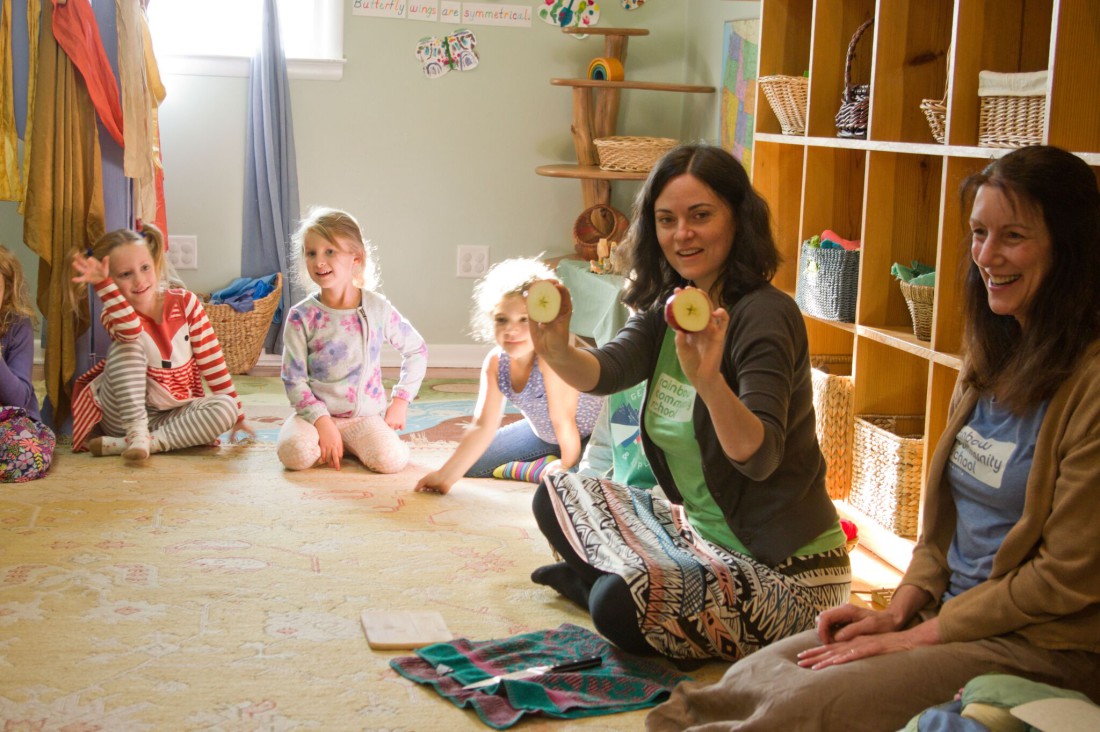“Educating the mind without educating the heart is no education at all.” ~Arisotle
It is a crisp fall morning at the Rainbow Community School, a private pre-K through eighth-grade school on Haywood Road in the middle of West Asheville. Fallen leaves from the large trees that surround the sprawling, 5-acre campus crunch underfoot as parents arrive to drop off their children for a day of learning.
Inside the school’s recently acquired auditorium, the former West Asheville Church of God, a collection of 50-60 local and regional educators, mental health professionals, counselors, parents, alumni and administrators gathered on Oct. 12 for an inaugural teaching conference titled “More Than Mindfulness: Exploring Education as a Sacred Art.”
Event coordinator and Rainbow’s curriculum coordinator West Willmore welcomed the assembly to the conference and thanked them for participating in this pilot experience. “Your commitment to social/emotional learning is incredible. Your commitment to being here, to dedicating your time and energy to exploring what it would mean to nurture the spiritual identities of children, is also incredible. This conference is about exploring education as a sacred art. That’s what this is. Education is sacred.”
The school’s executive director, Renee Owen, also welcomed the crowd and offered more insight about the teaching disciplines that Rainbow Community School has pioneered in its nearly 40-year history.
“The children are really who have invited you here today. This is a really rare and special opportunity for us to open up our doors like this. You’ll be joining us during our most sacred time of day, which is centering.” Owen’s opening remarks touched on the history of the school, which was founded in 1977 on a tradition of “not only acceptance, but an honoring of all spiritual traditions — not just religions, but all spiritual traditions, some of which transcend religion.”
She posed the question: “Why now for a conference on mindfulness?” She pointed out that in 2015 there were almost 650 studies conducted on mindfulness as a way to manage and relieve stress or anxiety, compared with 10 years ago, when hardly anyone used the word. She noted it’s become an accepted term in mainstream media. “Mindfulness is one aspect of spirituality. The great thing about mindfulness is it doesn’t send out the triggers … ‘spirituality’ often does, and I think that’s why it’s been so accepted. It’s been a bridge, as well as social/emotional learning, into this work of the heart, which is truly what education is.”
Owen also touched on how a daily routine of mindfulness through centering and meditation can continue to provide for her students as they graduate and enter their teenage years. “Adolescence is a key time for spirituality,” she said, although her voice began to tremble with emotion. “There’s a surge that goes on with adolescence, we’ve all seen it, we’ve all experienced it. We remember it, and we see it in our own children — the cognitive abilities that are exploding, everything that’s happening physically, the hormones that are occurring, social and emotional worlds are completely transformed.

“Well, exactly the same things are going on with a child’s spiritual life during adolescence. They are dying, literally dying, to explore their spirituality. And if they don’t have an opportunity to explore those larger questions in life [like] ‘Who am I?’ [and] ‘What is my purpose?’ and to have that fellowship with other adolescents that are going through that, then they’ll find other rites of passage, whether that be joining a gang or risky drug experimentation or other behaviors in order to get that transcendence, that emotional surge that they feel the need to fill. When adolescents have the opportunity to develop themselves spiritually, they have a greater emotional resilience to depression, addiction and sexual promiscuity.”
Owen cited current scientific studies of the brain with functional MRI studies and EEG scans that identify spiritual activities Rainbow Community School has seen through practical application and personal interaction with their students for decades.
“Here at Rainbow, we have always, intuitively, known without the science that this is who we are. We’ve always known that this is the core of being human — the interconnection that spirituality provides,” she said.
Members of the eighth grade led conference attendees in a centering and mindfulness exercise that opened with the gong-Om sound of a singing bowl and deep breathing. They invited participants to greet their neighbors in welcome. After a few minutes, order restored, attendees were asked to think about a person they just met and then to answer questions such as “What was the person’s hair color?” “Was it long or short?” “Did they smile?” The questions served as small road signs to awareness and connection. It worked. Where before the crowd noise had been a murmuring rustle of “good morning” and “nice to meet you,” the room bloomed into laughter and animated conversation as participants set aside their self-consciousness and focused instead on recognizing personal details of their neighbors.
The school limited the number of conference participants to 50 for this initial event to keep the experience intimate; this enabled attendees to experience the classroom environment personally and with a minimum of disruption. Attendees were broken into groups and led through two sessions of observation in classes at all levels, from preschool to middle school. After each classroom observation, attendees met for a 25-minute debriefing.
Board members, alumni parents and Owen herself led tours, offered personal insights through experiences and moderated the debriefing sessions, when attending educators had the chance to ask teachers about their classrooms on a technical level. The second half of the conference broke out into more detailed group workshops focusing on principles for teaching mindfulness and secular spirituality tools that would be accepted across a private or public school platform.

At the conclusion of the day, Willmore announced that the “More Than Mindfulness” conference was the first official activity of the new Rainbow Institute — a branch of RCS that will focus on teacher training, workshops, conferences, consulting, school startup, research and publications with the goal of becoming a national resource for holistic education.
“Rainbow Institute is forming a founding advisory team that will meet about four times this year to start designing Rainbow Institute’s structure and to theorize ways it can help spread holistic education,” Willmore said. “Ideally, by the end of this school year, we will have an understanding of Rainbow Institute’s main activities, initial funding mechanisms and a website off the ground. Renee Owen and I will be presenting at various national conferences about our unique educational model. We are planning a two-day More than Mindfulness Conference next Oct. 6 and 7 that will coincide with our 40-year anniversary and alumni event. We have some great keynote speakers already booked.”



Go Rainbow! My daughter went there for several years and those were her happiest school years. I’m so glad you’re spreading your grasp of what’s most important.
Thank you Mountain Express for this thorough article!